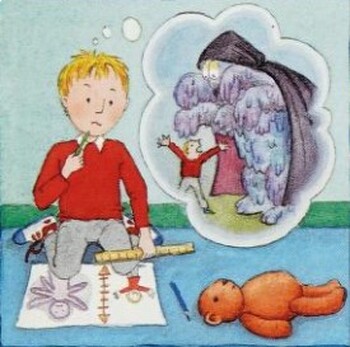Peter and the Bogeyman Reader's Theatre Script -Rubric and Questions
- PDF
Description
Grandmother
Peter! Look at the mess you have made!
Peter
It’s easy to clean up.
Grandmother
Are you going to clean up your muddy footprints?
Peter
No.
Grandmother
Then the Bogeyman will get you.
Peter
Have you ever seen the Bogeyman, Grandmother?
Grandmother
Certainly not. I was always too good, but I know all about him.
Peter
What does the Bogeyman do?
Grandmother
The Bogeyman sneaks up on naughty children and scares them. If that doesn’t do any good, then the Bogeyman uses his most powerful spell and turns them into salt. Then he carries them back to his castle, and puts them in his soup.
Included in the Peter and the Bogeyman Reader's Theatre Unit:
14 page script
10 characters + the narrator
41 questions ranging from easy to difficult
Student Reader's Theatre Evaluations based on 4 levels and 5 criteria.
Student Success Criteria
Student Friendly Goals
Reader's Theatre Checklist
Peter and the Bogeyman synopsis:
Peter is not a well-behaved boy. He is disobedient and messy. Peter's grandparents warn him that if his bad behaviour continues, then the Bogeyman will visit him one night, and turn him into salt for his soup. Peter asks around and does not receive a conclusive answer about the Bogeyman's existence, so he decides to tempt the Bogeyman out of hiding. Peter begins acting bad for an entire week, in an effort to coax the Bogeyman into visiting him. Will the Bogeyman visit Peter, or were his grandparents trying to scare him? If the Bogeyman exists, what will Peter do if if visits him?
Do not fear the reader's theater format. Students love these adapted stories because they are listening to the story and they are a part of the story by playing a character within the story.
Reader's theatre inspires reluctant readers to join in the fun. The strongest and most advanced readers in your class will encourage other students to raise their hand and participate in the story. I also use reader's theatre to add to my drama marks.
If the reader's theatre format did not work for my students and I, then I would have stopped creating and adapting them years ago.
Reluctant readers sometimes feel anxious looking at pages of text, whereas a reader's theater script is broken up into narration and different characters speaking, thus making the story more accessible to those students who have not discovered the incredibly fun activity of reading for entertainment.
I use shorter stories with minimal characters in literature circles.
When can one make time for a reader's theatre story in class?
When I am not reading a reader's theatre unit with my class, I usually reserve Friday's for the reading of a one-off story. It is an event that the class looks forward to, since they do not know which story I will choose. Great for Librarians. I project the stories on the screen and assign characters in class. Some characters only have 1 line. A character like that is perfect for a reluctant reader.
I have read these stories remotely/online and in class/in-person.
I encourage teachers and instructors to allow students to practice their parts at home before they read in front of the class. They can try different voices and tones when they practice.
I hope you, and your students have a fun time reading Peter and the Bogeyman.
Happy Halloween and Excelsior!
Mr. Marvel: The King of Reader's Theatre


